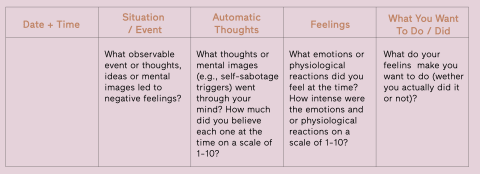Advertisement
Here's Exactly How To Stop Yourself From Self-Sabotaging In The Moment


There is a predictable linear progression from events to thoughts to feelings to behaviors. Once you understand the nature of how these components fit together, it will become more obvious to you where to intervene to stop the self-sabotage. If you could play your life in slow motion, here's what happens:

This sequence moves toward self-defeating behavior when triggers come into play. Self-sabotage triggers are basically something you think about—consciously or unconsciously—and those self-defeating self-sabotaging actions are a part of the behaviors you engage in as a result.

Knowing where triggers arise will help you to be able to intervene and stop the self-sabotage. As you look at this chain, it's clear that thoughts direct our feelings, which prompt our actions. For example, if you think someone is a reckless jerk for cutting you off on the highway, that thought will bring up feelings of irritation or even outrage and may lead you to honk your horn, or yell obscenities, or try to cut them off as payback. On the other hand, if you thought instead that the person cutting you off seemed like he was in a hurry and maybe didn't do it on purpose, your emotional reaction may be one of ambivalence, or even empathy, in which case you'd probably just keep right on driving. Your interpretation of an event directs your feelings and is often what ultimately leads you to act. Self-sabotage triggers get you to act impulsively and unproductively—it's a little like that instinct to flip someone off in traffic: an automatic response that may not be in your best interest.
Remember that the event can be something that is happening to you in the moment or the memory of something that has occurred in your past. The feeling that you are in danger and the associated feelings of being afraid (marked by your heart beating faster and your muscles tensing) is what prompts you to take a reactive stance and act in self-preserving ways—running away or avoiding the feared stimulus, whether it's a bear, a person you're dating, or a job you have been pursuing for the past weeks.
When either thoughts or feelings are left unchecked, they can lead to self-sabotaging actions. Breaking down this predictable sequence helps show where you can intervene to stop the self-sabotage actions from occurring. In fact, you can intervene at each step of the sequence, from when you first notice the self-sabotage triggers to when you feel the rush of negative emotions or physiological reactions, to when you begin to do self-sabotaging actions but haven't yet veered completely off course.
The best way to understand this sequence is to watch it play out in your own life, so let's dive into one of my favorite exercises: the Thought Record.
Understanding the moments when you self-sabotage.
A Thought Record is a visual way to represent your thinking as it occurs in specific situations and events to allow you to see in real-time how your thinking affects your feelings and behaviors. It is a classic cognitive behavioral therapy tool first created by Aaron Beck, M.D., and there are a number of forms it can take. The version below is one I developed for my clients. It provides a structured way for you to see how your thoughts, emotions, and behaviors emerge in a linear fashion and also allows you to evaluate your thinking so that you can respond to these thoughts and feelings in less self-sabotaging ways.
The next time you notice a negative feeling—whether it's an emotion that comes up, or you experience uncomfortable physiological reactions—ask yourself, What's going through my mind right now? In your journal, copy the chart below, document the date and time, and jot down the thoughts or mental images you are experiencing in the Automatic Thoughts column. Also take some time to note how much you believed in these thoughts on a scale of 1 (not really believing it at all) to 10 (believing it as much as you believe and know that the earth is round).
Then scroll back in your mental recollection and ask yourself, What was going on right before I had these thoughts? In the Situation/Event column, note some details about what was happening just prior to the emotion arising. The event can be either external in the form of an observable, objective event (like being laid off from your job) or an internal event like replaying a memory of a past event or visions of an imagined future event—for example, being scolded during a meeting for not following up with a client.
Next, consider the feelings you had that led you to use this Thought Record in the first place. If you felt particular emotions, write them down along with the intensity that you felt these emotions on a scale of 1 (barely registering) to 10 (feeling extreme discomfort, to the point where you can't focus on anything else in the moment). If you felt physiological reactions, write down a description along with the intensity that you felt these physiological responses on a scale of 1 to 10.
Finally, consider the last column. If you haven't acted on these negative feelings already, write down what you wanted to do when these negative emotions came on, whether it's hiding away in your home, reaching for a snack, or yelling at someone. Try to be honest and examine what your instinct was when these negative feelings came up and what you felt pushed to do. If you actually acted on your negative emotions, then write a few details that describe your actions.

From the book Stop Self-Sabotage by Judy Ho. Copyright © 2019 by Judy Ho. Published on August 20, 2019, by Harper Wave, an imprint of HarperCollins Publishers. Reprinted by permission.